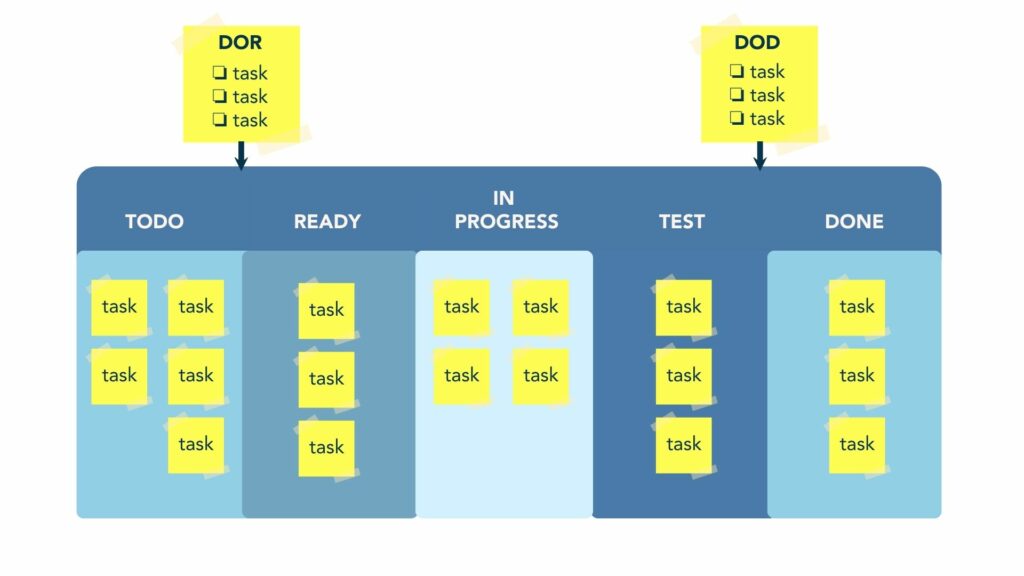Before starting a project head first, you must understand and master the importance of the fundamental concept of Definition of Ready (DoR), which transforms the way teams plan and execute tasks, acting as a warrant for success of an Agile model.
In this article, we’ll analyze typical criteria that a task or user story must meet to be considered as ‘’ready’’ in order to optimize your sprint’s start. Wemanity helps you digest this essential information as well as the setup of an Agile process.
1. Where Does the Definition of Ready Come From?
The idea of Definition of Ready (DoR) aims at improving efficiency and collaboration within development teams. Its origin lies in fundamental principles of Agile methodologies which emerged in the 1990s and were formalized with the Agile Manifesto in 2001.
The Manifesto’s goal is to promote collaboration, responsiveness to change, and continuous improvement. Faced with challenges from the modern VUCA market (Volatility, Uncertainty, Complexity, and Ambiguity), teams looked into how to better prepare, plan, and execute their job, leading to the birth of DoR. It refers to clear criteria that must be met before integrating a new element into a sprint.
The DoR solves problems which are frequent in agility, such as ambiguity of demands, lateness due to insufficient preparation, and flow interruptions. By setting clear criteria, teams make sure the preparation of the many work elements is done right.
Teams adapted their own DoR regarding their experience, leading to an evolution of those criteria through time.
2. What Is the Definition of Ready (DoR)?
Like the good old Harrap’s would do, a definition must start with an optimal sentence so that no ambiguity revolves around the concept. Basically, DoR is a checklist of everything that must be done for a product backlog element before the team may start working on it…
Obviously, a definition won’t suffice to master the concept of DoR! So let’s rephrase with a more advanced definition: DoR is used to define whether a task is ready to start, even before teams split the tasks or user stories into a sprint (a period during which the product owner, the scrum master, and the scrum team work to complete a specific product addition).
The Definition of Ready must be described in details and understood by team members before any project so that the completion time is correctly estimated and the right resources are given to achieve the allegedly Agile goal.
With the establishment of clear criteria to define when a task or user story is ready, the team makes sure all members involved share a common understanding of what must be achieved. It decreases ambiguity and quiproquo during the development process.
This way, the Definition of Ready acts as a list of criteria to help the decision process of a team before starting to work on a new task. Let’s not get mistaken between Definition of Ready and Definition of Done (DoD), which are different concepts.
3. Definition of Ready vs. Definition of Done: What’s the Difference?
Concepts of Definition of Done (DoD) and Definition of Ready (DoR) are essential within an Agile environment. They operate independently from each other to maintain quality and fluidity throughout the development process. The main difference between Definition of Ready and Definition of Done can be explained as follows:
- Definition of Ready (DoR): The DoR is dedicated to tasks, making sure there is a shared understanding of the key elements required for a task or a user story to be ready to be integrated within a sprint.
- Definition of Done (DoD): The DoD is dedicated to internal softwares and makes sure there is a shared understanding within the team about quality norms to assure the work is ready before publication.

Integrating a Definition of Ready avoids including incomplete or not detailed user stories into a sprint. Using a DoR decreases interruptions and disturbances during a sprint and increases focus and productivity during development. It therefore makes sure work can start and can’t be considered as completed.
Note: Do not get mistaken between ‘’ready’’ and ‘’to do’’. The ‘to do’’ row includes tasks to complete during the sprint, even if some are not ‘’ready’’ yet. 4. What Are the Advantages of the Definition of Ready?
- Planning improvement: With a well-defined and accepted Definition of Ready, the team can precisely predict the required energy for each task or user story when planning the sprint. This leads to more precise and completable sprint engagements.
- Alignment with user needs: By defining criteria to make sure user stories are well defined and aligned with the user’s needs, the Definition of Ready helps with the creation of high-quality products which will likely meet the client’s demands.
Risk reduction: A clear Definition of Ready helps with the identification of potential risks and loopholes in requirements early in the process, allowing the team to handle them before they turn into major problems later in the development cycle.
5. Definition of Ready: Some Examples
Stakeholders can use a Definition of Ready in Agile between themselves to clarify the project’s requirements and prioritize user stories in the sprint’s planning. Right below, you’ll find an example of a control list.
• The task or user story has a commercial value,
• The task or user story is understood by the development team,
• The task or user story is clear and well defined,
• The task or user story is achievable in a single sprint,
• The task or user story is measurable and testable once completed,
• Dependencies of user stories have been identified.
The Definition of Ready is also useful during outsourcing and subcontracting of tasks or during collaboration with external teams.
6. What Are the Key Elements of the Definition of Ready?
Here are the 4 key points to summarize the Definition of Ready (DoR):
- Full Description: Each user story must be clearly defined with enough details for the team to understand the goal and requirements.
- Acceptance Criteria: Conditions for completion of the user story must be defined to make sure it meets stakeholder demands and user needs.
- Dependencies and Prerequisites: Every dependency necessary to the user story’s completion must be identified and satisfied before starting development.
- Complexity Evaluation: The team must evaluate the user story’s complexity for a correct planning and an efficient task splitting.
7. What Is the Link Between Definition of Ready and the Agile Methodology?
One of the main advantages of the Agile methodology is the ability to find problems and create solutions in a quick and efficient way to continually improve your product and the team’s efficiency in the completion of their tasks.
To properly evaluate the preparation of a task, it’s essential it meets specific acceptance criteria, as explained above. Specific elements of DoR within an agile project include:
- Is the task achievable?
• Does the team know how to do it?
• Can they do it now?
• Is the task clear?
• Is there a shared understanding of what the task is and how to set it up?
• Is the task profitable?
• What is its commercial value?
• What is its value for the ultimate user?
• Has the team estimated the task?
• Can it be completed in a single sprint?
• What are the acceptance criteria?
• Is there an efficient way to test the functionality of each user story?
• Once done, what makes it complete?
• Does the team understand how to evaluate it in the sprint review once it is done? (That’s where the Definition of Done starts.)
8. Setting Up a DoR: How to Proceed?
In order to efficiently set up the Definition of Ready (DoR) within Agile teams, it’s crucial to adopt a meticulous strategic approach which will be deployed progressively through several steps…
1. Open collaboration for a clear vision
The DoR must come from a transparent discussion and be approved by the whole team, not only project managers. Including every team member comes as a crucial step to make sure every opinion is considered. This gives a holistic vision of the user story. The variety of roles and experiences enhances the DoR, leading to an optimal convergence towards a common goal.
2. Flexibility and ongoing evolution
It is essential for the DoR to be updated regarding the project’s changing needs and specific context. It is not static, but rather in a constant evolution. It adapts to the team’s growth in terms of confidence and maturity. This agility guarantees its relevance throughout time.
3. Definition aligned with user expectations
A personnalisation of the Definition of Ready (DoR) regarding user expectations appears as essential to make sure the designed characteristics efficiently match user needs. This adaptation enhances the alignment between deliverables and actual preferences of the user, therefore improving satisfaction.
4. Limits and different use
The Definition of Ready (DoR) is an important guideline in Agile methodologies to make sure elements are sufficiently prepared before entering the development stage. However, despite a guiding role, the DoR can’t anticipate all complexities and uncertainties that might come up during development. Knowing this, is crucial to apply the DoR correctly. It’s necessary to acknowledge that every project can have its own specific requirements and unique challenges and that the DoR must therefore be adaptable and adjusted in consequence to be aligned as close as possible with the project’s reality while remaining coherent with your top objectives.
5. Complementary methods and optimization of agile projects
Aside from the DoR, other methods such as the Definition of Done (DoD) or Story Mapping can play a crucial role in the improvement of performance and quality of agile projects. Their combined use can maximize the team’s efficiency and the client’s satisfaction.
At Wemanity, we strongly believe in the DoR for an elevation of performance in agile projects. We guide you with the optimal DoR setup, as well as with other methods adapted to your needs. Other methods can also strengthen your agile pratctices and lead to sustainable results for the setup of an agile approach.
To get to know better the way the Definition of Ready (DoR) optimizes your Agile pracices, explore our expertise and discover how we can guide you with the setup of a sustainable Agile approach.
In summary
The Definition of Ready (DoR) describes a list of essential criteria that must be met before starting an Agile project. It acts as a warrant for a sufficient preparation of a task or element before starting to work on it, therefore creating a shared understanding of expectations and prerequisites from the start of the process.
The main difference lies in their application: DoR is applied ahead of the start of a project of the inclusion of elements into a sprint, while DoD focuses on quality norms for the finished product. The DoR aims at avoiding the inclusion of any insufficiently prepared element, therefore enhancing focus and efficiency during the sprint or the project.
The DoR allows for a better planning thanks to more precise evaluations, an alignment of elements with user needs from the start, and the identification of risks. This leads to better defined sprint or projects, a better quality of deliverables, and a decrease in disturbances.
One of the main advantages of the Agile methodology is the ability to find problems and create solutions in a quick and efficient way to continually improve your product and the team’s efficiency in the completion of their tasks. DoR allows to do so even before the task starts.












